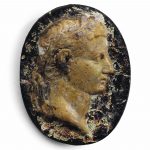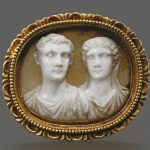During the Roman period the cameo technique was used on glass blanks, in imitation of objects being produced in agate or sardonyx. Cameo glass objects were produced in two periods; between around 25 BC and 50/60 AD, and in the later Empire around the mid-third and mid-fourth century. Roman glass cameos are rare objects, with only around two hundred fragments and sixteen complete pieces known, only one of which dates from the later period. During the early period they usually consisted of a blue glass base with a white overlying layer, but those made during the later period usually have a colourless background covered with a translucent coloured layer. Blanks could be produced by fusing two separately cast sheets of glass, or by dipping the base glass into a crucible of molten overlay glass during blowing. The most famous example of a cameo from the early period is the Portland Vase. Wikipedia
Below are some examples of Roman cameo brooches including a gold and glass cameo brooch circa 2nd-3rd century AD and a sardonyx cameo of Caligula and Antonia Minor.





